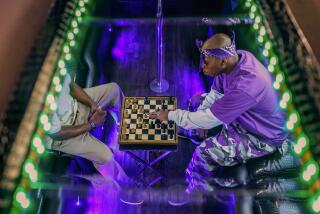A Lesson From the Masters
- Share via
Reigning chess champion Gary Kasparov sat opposite his challenger, Anatoly Karpov, ready to begin the second game of the world title match. For the next hour the two Soviets, the world’s greatest chess minds, will battle for control of the board, launching attacks and building defenses.
“It’s a war going on,” said chess player and English teacher Steve Hughes.
But the war was not being waged under the glare of television lights in Macklowe Center in New York’s Times Square, site of the world championship match, but in a classroom at San Fernando Junior High School.
Hughes and his 10-member junior high school chess team are joining fans worldwide in re-creating the games being played between Kasparov and Karpov in the title match that started last week.
The two Soviets are scheduled to play 24 games in the $3-million championship match. Using the game results printed in the newspaper, Hughes re-creates the tension of each game much as radio announcers once called baseball games using inning-by-inning telegraph reports.
Team members each move the chess pieces on their own boards as Hughes calls out the moves in a form of chess shorthand known as algebraic notation. “OK, Karpov defends with knight C6, he’s throwing down his gauntlet,” said Hughes of the game’s opening. “But Kasparov goes into Karpov’s back yard. He’s trying to pound Karpov.”
Hughes’ after-school re-creations of the championship games are just the sort of drill the players need to hone their skills, he said. Using a large paper game board on which he records the moves in the front of his classroom, Hughes peppers his players with questions about the strategy played by the battling Soviets.
The match’s second game, played Wednesday, ended in a decisive victory by Kasparov. As Hughes told his team, the victory was especially important to Kasparov because the game began with the ancient “Ruy Lopez” opening, of which Karpov--playing the black--is considered the master.
When Kasparov began his assault on Karpov’s king, Hughes told his students:
“OK, move 25, Kasparov plays his bishop, this is the beginning of the end. He probably took 15 minutes for this move and when it came it came like a thunderbolt,” Hughes said. “Analyze the move. What is Karpov’s move? Come on, what’s the threat? Look four or five moves deep. Don’t make the moves on the board. Visualize. You’re in training.”
Students yell out possible moves, point out the dangers facing Karpov and make suggestions for the defense of his king.
“If Karpov can squirm out of this, it will be the swindle of the century,” Hughes said.
For the moment, it appeared that Karpov had a chance. Then it was over. He resigned the game, shook hands and walked off.
For the San Fernando team, which plays daily during lunch and after school, the once every three years championship match is like the Super Bowl.
“They’re hot,” said Jesse Reyes, 14, the team’s No. 1 player, of the contestants.
The school has become a powerhouse in junior high school competition since Hughes began coaching the chess team in 1988, teaching the game to students from the largely Latino, blue-collar neighborhood. The school’s team finished 12th among 500 competitors in the 1990 National Junior High School Chess Championship in May.
Hughes, former president of the UCLA Chess Club and current president of the Santa Monica Chess Club, predicts this year’s team will be even better than last year.
When Hughes finishes calling the game, it is past 4 p.m., and more than an hour has passed. Team member Juan Curiel, 14, said it was a great game.
“I’m learning not to do the same mistakes that hurt Karpov,” Juan said. “I like the way Kasparov was looking ahead in his moves.”
Juan’s brother, Albert, 12, gives the game high praise, especially for a youngster raised in the age of fast-action video games. “It was too short,” he said.
More to Read
Go beyond the scoreboard
Get the latest on L.A.'s teams in the daily Sports Report newsletter.
You may occasionally receive promotional content from the Los Angeles Times.










